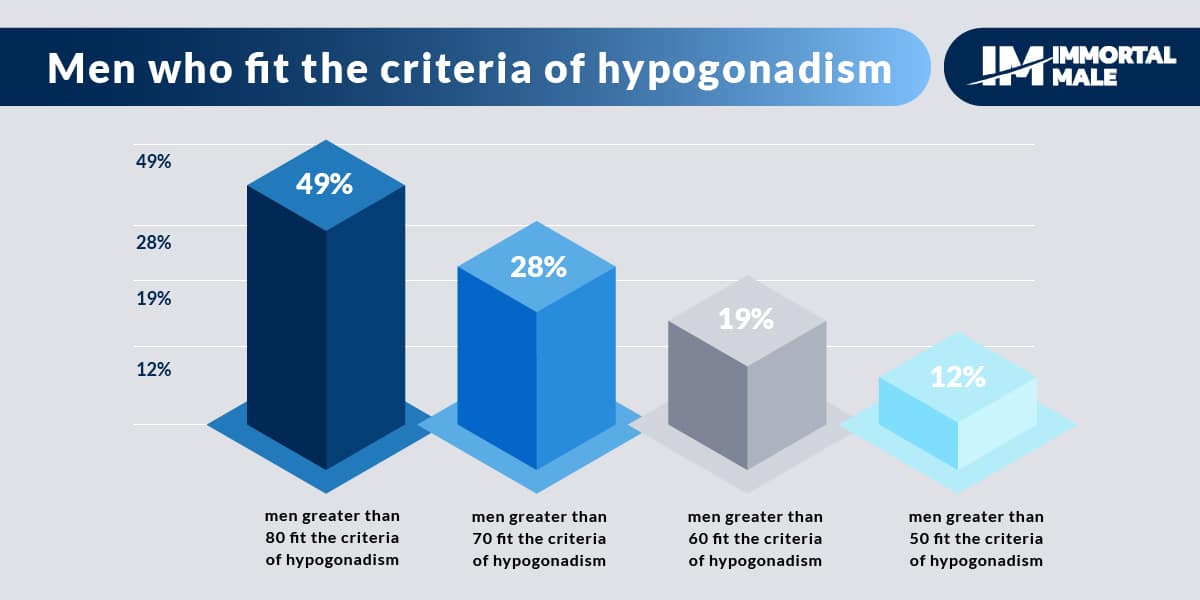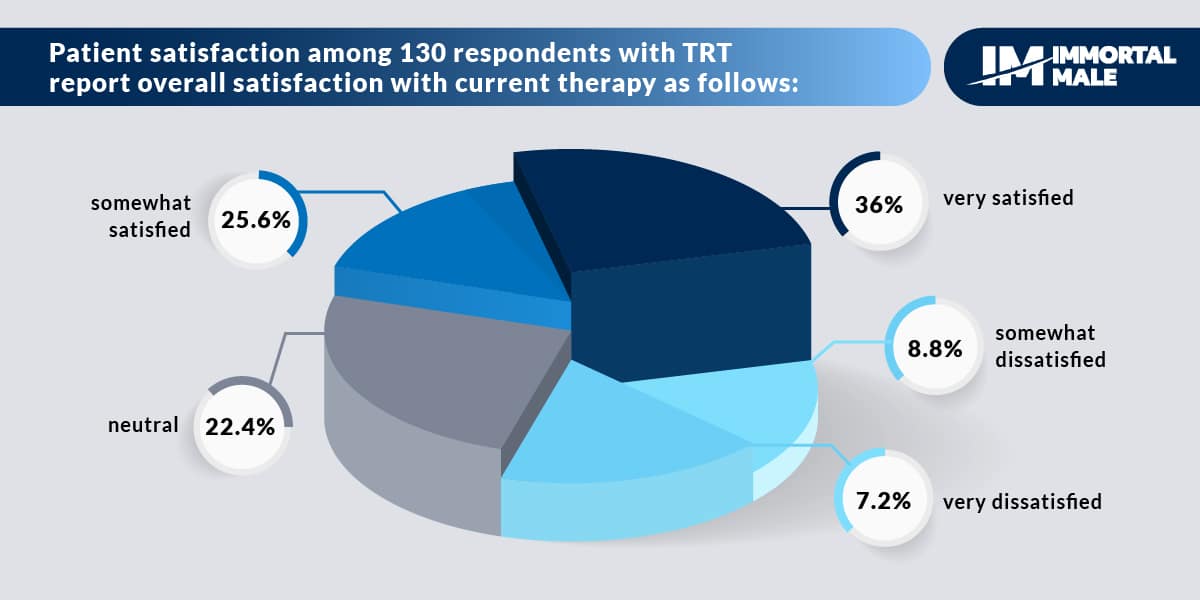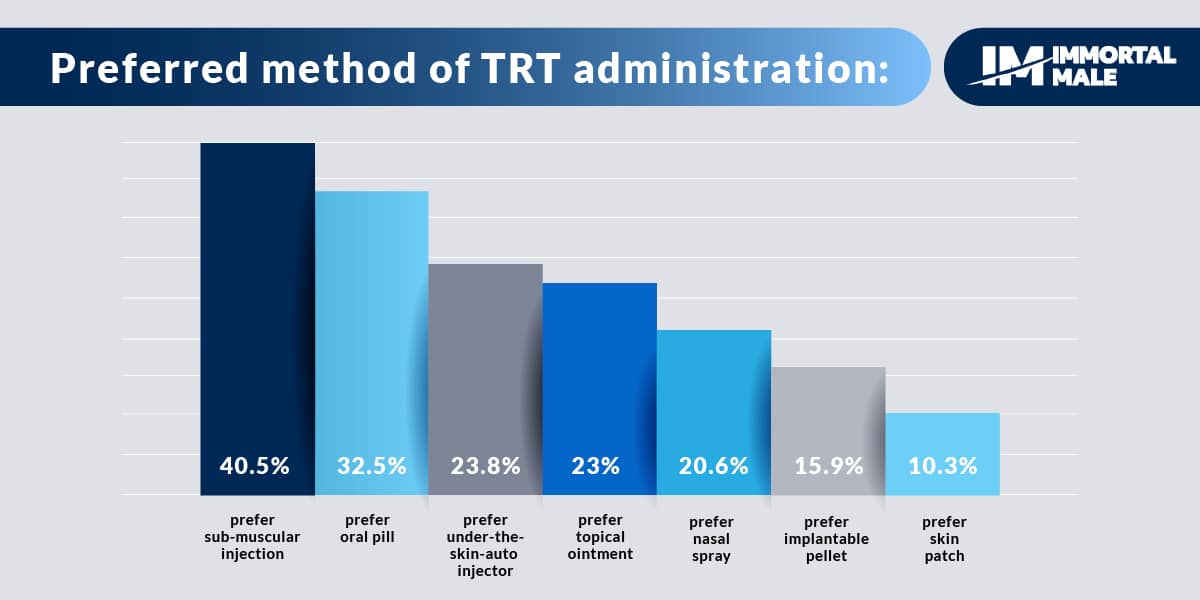Starting TRT can be overwhelming, but this article will help answer the question “is TRT dangerous?” so you can feel more at ease about starting.

Are you asking yourself, “is TRT dangerous?” Testosterone has an important role in the development of male sex characteristics during adolescence, along with the maintenance of secondary sex characteristics associated with masculinity in adulthood.1 Serum testosterone concentrations in healthy men are expected to fall within a normal range of 300 ng/dL to 1,000 ng/dL, depending on the patient’s age.2
Many people may wonder, “is TRT dangerous?” This article will help dispel myths about TRT so you can feel more at ease about starting.
Maintaining testosterone concentrations within this healthy range is important for protecting a patient’s physical, emotional, and mental health. When men’s testosterone levels are less than 300 ng/dL, they may have clinical testosterone deficiency.2 Accurately diagnosing clinically low testosterone, or hypogonadism, requires an evaluation of patient symptoms in combination with the measurement of how much serum testosterone the patient has.
Testosterone replacement therapy is a treatment process for hypogonadism. Testosterone treatment provides the body with an external source of testosterone so that testosterone levels can be brought back into the normal range.
TRT can be delivered to the body through several different methods, including injections, gels, patches, and oral pills. Testosterone is prescribed at a dosage that will help each patient restore serum testosterone concentrations to a level within the natural range. It takes several months of treatment to feel the full effects of testosterone replacement therapy. Some may ask themselves, “is TRT dangerous?” Proper treatment is safe and effective.
So, is TRT dangerous? There are many inquiries on if TRT is dangerous and how it can affect patients. Some of the most common myths about what TRT is like will be explained below.
Decreased levels of serum testosterone are associated with aging. However, testosterone concentrations that fall below 300 ng/dL are abnormal for the aging process. Patients who have testosterone concentrations less than this, in combination with the symptoms of hypogonadism, may be eligible for testosterone replacement therapy. According to the European Male Aging Study, 2.1% of men with low testosterone are hypogonadal.3
The study also found that the prevalence of hypogonadism in men with low testosterone increases with age: 0.6% in men 50 to 59 years old, 3.2% in men 60 to 69 years old, and 5.1% in men 70 to 79 years old.3 It is important to speak with a medical care provider to determine if your low testosterone levels are a result of the normal aging process or if they have been caused by hypogonadism.
Read on to learn more about the effects of TRT and discover the answer to the question, is TRT dangerous?

Everything is best served in moderation, and testosterone treatment is no different. Testosterone levels that far exceed the upper end of the normal range can also cause issues for patients. Patients with testosterone concentrations higher than 1000 ng/dL may experience heart muscle damage, shrinking of the testicles, prostate enlargement, aggressive behavior, acne, and other symptoms.
For men who are hypogonadal, TRT treatment will not raise testosterone concentrations to a level beyond the healthy range. Men who have not been diagnosed with hypogonadism are not eligible for testosterone treatment.
Is TRT dangerous? Your primary care physician is an important member of your medical care team, and it is important to know that they can prescribe testosterone to you. However, the additional benefits offered by TRT treatment packages will likely not be included in a traditional prescription format.
Testosterone replacement therapy exists to help resolve the symptoms of hypogonadism, which does not stop at erectile dysfunction. The potential benefits of testosterone replacement therapy include improved libido and erectile function, increased bone mineral density, increased muscle mass, and improved mood and cognitive function.4 Men who have been diagnosed with hypogonadism and who are hoping to see any of the benefits of TRT in their life should speak with a TRT treatment provider to begin treatment.
Many people are under the impression that it is overly expensive to get TRT. However, testosterone replacement therapy is an affordable treatment process. Prices for TRT treatment range from $150-$1500, but some of the more expensive treatment options are not always necessary.
Many patients may ask, “is TRT dangerous?” It is comforting to know that testosterone replacement therapy is a safe process when it is well monitored and used as directed. Testosterone replacement is specifically intended for men with diagnosed hypogonadism. Adverse events may occur in patients who misuse testosterone. Patients should always seek testosterone treatment from specific TRT providers who prioritize patient safety and comfort.

Is TRT dangerous? Fortunately, many testosterone facts support the effectiveness of low testosterone therapy for hypogonadism.
Testosterone concentrations in men begin to decline after the age of 40.7 Clinically relevant low testosterone is more common in older men, with 50% of men older than 80 and 40% of men older than 45 being diagnosed with hypogonadism.8
However, young adult men can also experience the signs of low testosterone. Hypogonadism can be caused by a range of conditions and events including infections, trauma, diabetes mellitus, and testicular cancer.8
Read on if you want to answer the common question, “is TRT dangerous?”
The current evidence does not support a causative relationship between TRT and increased risk of experiencing a cardiovascular event.9
A systematic review of 75 placebo-controlled randomized clinical trials, found that testosterone replacement therapy is not associated with an increased risk of cardiovascular events.10 Men who are concerned about their cardiovascular health during the TRT treatment process should bring up their concerns with their TRT provider.
Testosterone replacement therapy helps to resolve the physical, mental, and emotional symptoms of low testosterone. In a study of 3,090 participants, treatment with any TRT type was associated with significantly improved quality of life as compared to a non-treatment group.11
In another study, 750 hypogonadal men treated with TRT reported improved quality of life over a period of 36 months after the initiation of treatment.12
Testosterone replacement treatment programs that offer long-term monitoring and that center patient wellbeing are great for those asking “is TRT dangerous?” However, it is considered an overall safe treatment option for hypogonadal men.
Is TRT dangerous? TRT is used with the intention of reducing hypogonadal symptoms in men with low testosterone, while performance-enhancing steroids are used with the intention of elevating testosterone concentrations to an abnormal level in the hopes of gaining muscle mass and improving athletic performance.14
One of the most important facts to note is that TRT is not a performance-enhancing steroid. Testosterone taken for the treatment of hypogonadism is both legal and safe.
Do you find yourself asking, “is TRT dangerous?” TRT is prescribed at a dosage that will bring the patient’s concentrations into the range of normal testosterone levels, 300 ng/dL-1000 ng/dL. Performance-enhancing steroids are used by individuals at a much higher dosage than the dose used for TRT. The dosage of performance-enhancing steroids elevates testosterone levels to a concentration beyond the healthy range, which is why it’s generally associated with weightlifters and those looking to gain a large amount of muscle.

Is TRT dangerous? There are several options for delivering testosterone to the body. Each option has its own advantages and disadvantages.
Intramuscular testosterone is a TRT replacement therapy option that yields slow-release of testosterone over the course of 2-4 weeks. Testosterone cypionate, testosterone enanthate, and testosterone undecanoate are approved by the FDA for use in the United States. Severe reactions have been documented in patients treated with testosterone undecanoate, and as such, the testosterone undecanoate preparation is restricted for use in special cases only.15
Is TRT dangerous? Testosterone cypionate and testosterone enanthate injections have proven to be effective methods for raising serum testosterone concentrations into the healthy range. One of the major advantages of intramuscular testosterone injections is that patients only need to receive a testosterone dose once every 2-4 weeks. A disadvantage to this method is that testosterone levels will begin to decline in the days preceding the next scheduled dose. Well-managed TRT programs can help patients to schedule doses so that the symptoms of declining testosterone levels are not felt by the patient.15
Testosterone patches are an effective method of testosterone administration, however, they don’t work for everyone. Patches are applied to the back, abdomen, upper arms, or thighs, and the site needs to be rotated between patches. Patches need to be applied to the skin nightly to achieve daily testosterone concentrations within the desired range.15
Also, patches can cause irritation to the skin along with skin blistering and pruritus. Advantages of the patch are ease of use and quick reversal of testosterone concentrations following removal.15
Is TRT dangerous? As aforementioned, TRT replacement therapy is used when individuals have been diagnosed with hypogonadism and are seeking relief from their symptoms. To reiterate, hypogonadism is diagnosed when patients have a serum testosterone concentration less than 300 ng/dL in combination with specific symptoms. Read on to learn the effects of TRT and if TRT is dangerous.
The benefits of TRT begin to be felt within 3-4 weeks after the first dose of testosterone. Patients will experience significant positive changes before and after testosterone therapy, but it takes about 6 months to feel the maximum benefits of TRT.16
The first testosterone therapy benefits patients will notice are those of improved libido and improved mood within the first month of treatment. Testosterone’s effect on the body within 3-4 months of the initiation of treatment includes reduced fat mass, increased lean body mass, increased muscle strength, and improved glycemic control.16
At 6 months of treatment, patients will see the maximum effects of these results along with increased bone density and better lipid management within the body (meaning reduction of LDL cholesterol and elevation of HDL cholesterol). Patients who continue TRT treatment beyond the 6-month mark will continue to feel the benefits of healthy testosterone levels in their body.16
Is TRT dangerous? Some of the signs of low testosterone include:
If you have any of the following conditions, receiving TRT may not be for you:
There are many diseases, disorders, and events that can cause hypogonadism, which is defined as either primary or secondary. Primary hypogonadism may be caused by Klinefelter’s syndrome, injury to the testicles, cancer treatment, and normal aging, among other issues.18
On the other hand, secondary hypogonadism is caused by an issue in the hypothalamus or pituitary gland of the brain, along with inflammatory disease, pituitary disorders, obesity, and certain medications.18
Is TRT dangerous? Patients are advised to speak with a medical care provider to determine if they have hypogonadism and to decide if TRT therapy is the right treatment option for them. A medical care provider will also be able to help each patient identify the cause of hypogonadism in their life.

Are you or a loved one searching for the answer to the question, “is TRT dangerous?” Immortal Male is a premier provider of testosterone replacement therapy. At Immortal Male, patient safety and comfort are the priority from day one. Patients are able to contact a team of educated Immortal Male employees with questions about testosterone facts at any time during the TRT therapy process.
Before starting treatment, patients are evaluated for hypogonadism through testing at an accredited laboratory and communication with an Immortal Male nurse. Patients will also be able to speak with the Immortal Male staff to help develop a treatment plan that suits their lifestyle and individual goals for testosterone replacement therapy results. Once treatment begins, patients will be well on their way to a higher quality of life.
Throughout the entire treatment process, patients will be able to ask questions and work with their provider to adjust the treatment as necessary. Immortal Male makes testosterone treatment an accessible option for any man seeking relief from the symptoms of hypogonadism. If you or a loved one find yourselves wondering, “is TRT dangerous?” and want to learn more, contact Immortal Male today.
Immortal Male is an online clinic that helps men optimize their hormones.
As part of your membership and as medically indicated, physicians prescribe medications, and recommend supplements that are delivered to you from the comfort of your home.